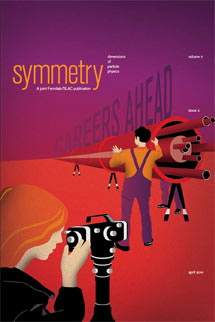A Diamond is a Diamond...
until It's Very Small
Diamondoids researcher Jeremy Dahl.
(Photo by Kelen Tuttle.)
by Nicholas Boch and Olga Kuchment
In a basement lab on the Stanford University campus, Jeremy Dahl pulls out a vial of what looks like fine white powder.
"Here they are," he says with a grin, tilting the vial back and forth.
The powder is actually a pile of miniscule diamonds, or diamondoids. The tiny gems are so small that even the big ones are measured only in micrometers—millionths of meters. But if researchers with the Stanford Institute of Material and Energy Science are successful, diamandoids could become a lot bigger, showing up in everything from home electronics to pharmaceuticals.
Right now, Dahl is one of the only people in the world who can produce diamondoids, making SIMES the nexus of diamandoids research. The program got a big boost last July, when SIMES researcher Nick Melosh
received a $2.5 million Department of Energy Single Individual and Small
Group Research grant to study the properties and potential applications of the materials.
Diamonds are composed of cages of interlocking carbon atoms. While a carbon atom at the center of a diamond is bound to four other carbon atoms, a carbon atom at the diamond's surface is bound to only three, with exposed space filled by a hydrogen atom. As the size of the diamond decreases into the micrometer range, the ratio of hydrogen atoms to carbon atoms increases, eventually altering the
behavior of the material.
Read more...
Public Lecture May 25: Jeremy Dahl on Ultimate Atomic Bling
(Poster by SLAC InfoMedia Solutions.)
Diamonds exist in all sizes, from the Hope Diamond to minuscule crystals only
a few atoms across. The smallest of these diamonds are created naturally by the
same processes that make petroleum. Recently, researchers discovered that these
"diamondoids" are formed in many different structural shapes, and that these
shapes can be used like LEGO blocks for nanotechnology. Come
to Panofsky Auditorium Tuesday evening, May 25 at 7:30 p.m., to hear diamondoids researcher Jeremy Dahl of the Stanford
Institute for Materials and Energy Science present a public lecture, "Ultimate
Atomic Bling." Dahl will discuss the discovery of these nano-size diamonds and highlight current SLAC/Stanford research into their applications in electronics and medicine.
The talk is free and open to all.
April 2010 Issue of Symmetry Now Online
by Glennda Chui, Symmetry Breaking

Symmetry magazine, April 2010. (Image: Sandbox Studios.) In this issue:
Plus: A new school of physics in Africa; the now-you-see-it, now-you-don’t quantum art of Julian Voss-Andreae; a little-known product of particle accelerators that lives inside your house, your office and your car; a giddy fan collects physics autographs; the neutrino explained in 60 seconds; and more.
A pdf of the issue is available for download here.
As always, we love to hear from readers. Send us your thoughts at letters@symmetrymagazine.org or use the handy links at the bottom of each article.
|




 <%
Response.AddHeader "Last-modified", getArticleDate()
'Response.AddHeader "Last-modified","Mon, 01 Sep 1997 01:03:33 GMT"
'Monday, December 06, 2010
%>
<%
Response.AddHeader "Last-modified", getArticleDate()
'Response.AddHeader "Last-modified","Mon, 01 Sep 1997 01:03:33 GMT"
'Monday, December 06, 2010
%>